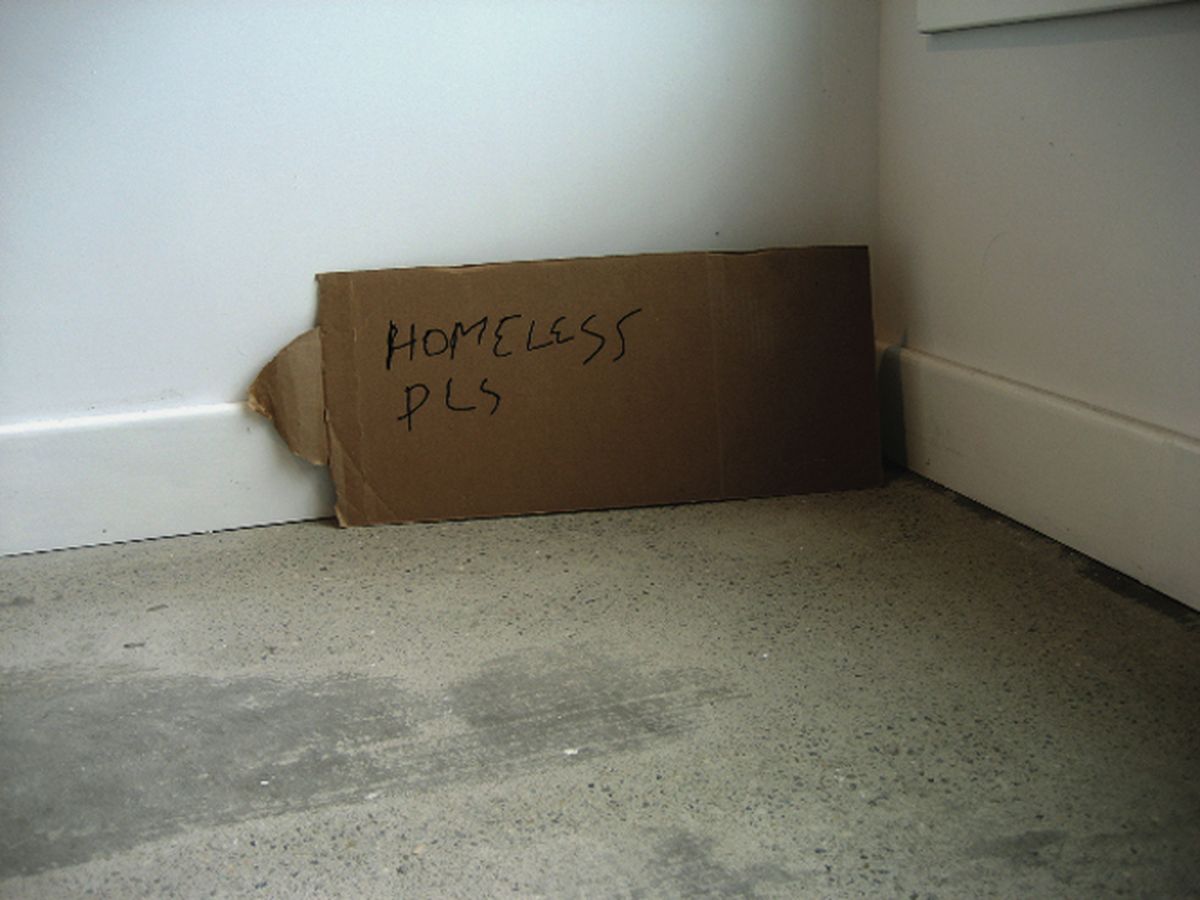On the Wall Jennifer Zurlini
Saranac exhibit puts emphasis on homeless

If you are reading this newspaper after fetching it from your front doorstep, Happy Thanksgiving! You have a lot to be thankful for. Namely, you’ve got a home.
Saranac Art Projects’ current exhibition, “Art Feeds the Homeless,” is one part art, one part heart, and one part awareness, with a food drive attached.
The show was curated by Jennifer A. Gately, formerly of Northwest Art at the Portland Art Museum. She brings together “two artists practicing different forms of social engagement by exploring conflicting ideas of place and marginalized communities, as diverse as retirement homes and the streets,” wrote Megan Murphy, founder of Saranac Art Projects.
Murphy said she teamed up with Main Market Co-op, a local food cooperative scheduled to open in downtown next fall, “to reach out to our own community in this season of giving and actively demonstrate the content of the artworks on display, which relate to requests for food and people helping one another.
“The food drive gives people a cathartic way to act out and feel like they’re participating,” rather than just observing the problem, she said. Remember to bring a nonperishable item with you.
Harrell Fletcher
“Art and social practice” is a new genre in art. Its many mediums include video, photography, performance art, sculpture, text and sound.
An act of social engagement, creativity and ideas from contemporary art movements are tied to sociology, environmentalism, anthropology, journalism and social work, creating an ongoing dialogue between artist and viewer. Art for art’s sake has become art for our sake.
Harrell Fletcher, an artist living in Portland, runs an MFA program at Portland State University. He developed the Art and Social Practice emphasis for the fine arts department, and his name comes up first when you search the Web for artists practicing in this genre.
“There is a very small percentage working in this way across the country and even in the world, but the numbers are rising,” Fletcher said.
“The basic idea is to see how artists work if their primary structure is not the traditional studio/gallery model which encourages the production of sellable objects like paintings, etc.,” he explained. “For our program there is also an emphasis on collaboration and audience participation.”
Fletcher’s time-based installation at Saranac Art Projects includes two videos, running one after the other on the gallery’s main wall. They are both artistic adaptations of James Joyce’s epic novel, “Ulysses,” and were part of the Whitney Biennial in New York in 2004.
“Blot Out the Sun” (22 minutes, 13 seconds) is set in a Portland community service station. Mechanics, as well as drivers who pull up for gas, read the script, which is mostly one- and two-liners about “death, love, social inequality and the relationship between individuals and the universe,” wrote Fletcher.
The theme of mechanics works as a striking metaphor in a society in dire need of a tune-up.
As the readers present their lines, their level of understanding varies, “but often it started a conversation about what the lines meant and I think that was an interesting effect,” Fletcher said.
In “The Problem of Possible Redemption” (13 minutes, 25 seconds), old folks at the end of their lives, living in a senior center, are the narrators in this work about mortality and the fragility of the human condition.
Marc Dombrosky
Marc Dombrosky’s work with found cardboard signs, notes, scraps and papers brings the realities of homelessness indoors.
Dombrosky’s found and embellished signs are placed on the floor in Saranac Art Projects, as they were in his Portland Art Museum exhibition, forcing the viewer to engage and interact with them as if walking around a homeless person sitting on the sidewalk.
“(The ground) is also a reference to the origins of many of the works, as I’ve picked them up from the gutters on the side of the street, planters, alleys, and sidewalks,” he said.
The artist then embroiders each handwritten sign, matching the color of the thread to the ink and the width of the thread to the lettering, in an exacting way.
“The act of spending time making the piece(s) definitely draws connections with the writers, and gives me the physical and psychological space to consider the people who made these signs originally, how we perceive and make contact (with) disadvantaged members in our community, and what it means to re(deploy) these works back into the world – altered, recoded,” the Tacoma artist, a professor of art at Cornish College of the Arts in Seattle, said in an e-mail.
“Advocacy is becoming more and more of a question in my practice, as I focus in on certain subjects in the works collected for Saranac – homelessness (the need for shelter, in multiple ways), loss, fatigue – but I’m not attempting to stop the conversation there,” Dombroksy said.
“How can these works offer a broader platform for visitors to map their own experiences onto the project? Hopefully, these works ask more questions than they answer.”
Jennifer Zurlini can be reached